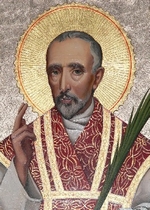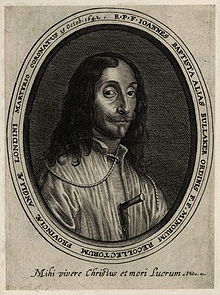
The Forty Martyrs of England and Wales or Cuthbert Mayne and Thirty-Nine Companion Martyrs are a group of Catholic, lay and religious, men and women, executed between 1535 and 1679 for treason and related offences under various laws enacted by Parliament during the English Reformation. The individuals listed range from Carthusian monks who in 1535 declined to accept Henry VIII's Act of Supremacy, to seminary priests who were caught up in the alleged Popish Plot against Charles II in 1679. Many were sentenced to death at show trials, or with no trial at all.

Edmund Arrowsmith, SJ was one of the Forty Martyrs of England and Wales of the Catholic Church. The main source of information on Arrowsmith is a contemporary account written by an eyewitness and published a short time after his death. This document, conforming to the ancient style of the "Acts of martyrs" includes the story of the execution of another 17th-century recusant martyr, Richard Herst.
John Roberts, OSB was a Welsh Benedictine monk and priest, and was the first prior of St. Gregory's, Douai, France. Returning to England as a missionary priest during the period of recusancy, he was martyred at Tyburn. He is venerated as a saint by the Catholic church.

John Jones, also known as John Buckley, John Griffith, Godfrey Maurice, or Griffith Jones was a Franciscan friar, Roman Catholic priest, and martyr. He was born at Clynnog Fawr, Caernarfonshire (Gwynedd), Wales, and was executed 12 July 1598 at Southwark, England. He is one of the Forty Martyrs of England and Wales.
Thomas Sherwood was a Catholic layman and martyr. He was arrested on suspicion of treason, having visited a house where it seems that Mass was secretly celebrated.

William Exmew, O.Cart was an English Catholic priest and Carthusian hermit. He was hanged, drawn, and quartered at Tyburn and is honoured as a martyr by the Catholic Church. Exmew and his brother Carthusian martyrs were beatified by Pope Leo XIII on 9 December 1886.

John Southworth was an English Catholic martyr. He is one of the Forty Martyrs of England and Wales.

Philip Powell was a lawyer who became a Benedictine monk and priest, serving as a missionary in England during the period of recusancy. He was martyred at Tyburn.
Maurus Scott, born William Scott, was an English lawyer who became a Benedictine monk and priest, serving as a missionary in England during the period of recusancy. He was executed at Tyburn, and is a Catholic martyr.

Irish Catholic Martyrs were 24 Irish men and women who have been beatified or canonized for dying for their Catholic faith between 1537 and 1681 in Ireland. The canonisation of Oliver Plunkett in 1975 brought an awareness of the others who died for the Catholic faith in the 16th and 17th centuries. On 22 September 1992 Pope John Paul II proclaimed a representative group from Ireland as martyrs and beatified them.

Arthur Bell, OFM was an English Franciscan martyr. He was found guilty of being a Roman Catholic priest by a court sitting under the auspices of Parliament during the English Civil War. He was executed at Tyburn in London. Bell was beatified by Pope John Paul II on 22 November 1987.

Henry Heath (1599–1643), religious name Paul of St. Magdalene, was an English priest of the Order of Friars Minor and a Roman Catholic martyr.
John Bullokar (1574–1627) was an English physician and lexicographer. He was born in St Andrew's parish, Chichester, Sussex, and baptized there on 8 November 1574, third of four known children of Elizabeth and William Bullokar.

Thomas Maxfield was an English Roman Catholic priest. He is a Catholic martyr, beatified in 1929.

George Haydock was an English Roman Catholic priest. He is a Catholic martyr, beatified in 1987. He is not to be confused with his relative, also a priest, George Leo Haydock (1774–1849).
John Lockwood was an English Roman Catholic priest. He is a Catholic martyr, beatified in 1929.
William Dean or Deane was an English Roman Catholic priest. He is one of the Catholic martyrs, beatified in 1929.
Thomas Holford (1541–1588) was an English Protestant schoolteacher who became a Catholic priest during the reign of Queen Elizabeth I. He was martyred at Clerkenwell in London, and is recognised by the Catholic Church as having the status of Blessed.
John Talbot was an English Catholic recusant and martyr.











